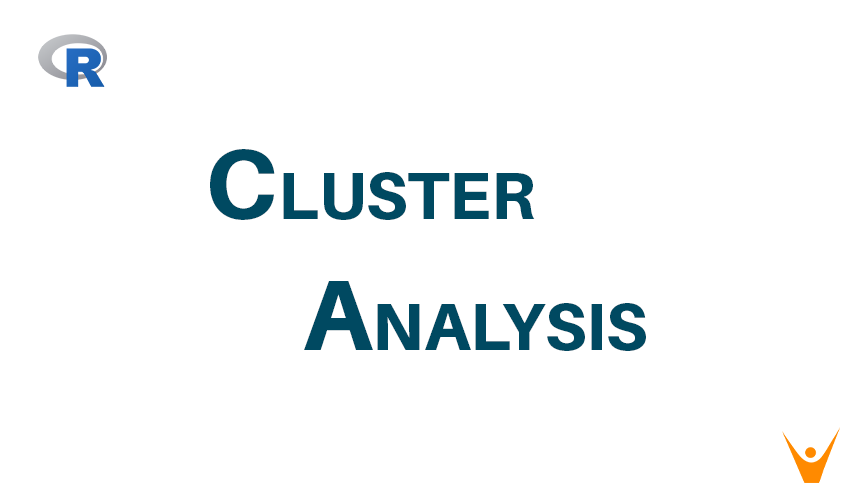In this article, we will learn the fundamental cluster analysis in the R language. We will understand different methodologies like K-Means and Hierarchical Clustering. Also, further, we will explore its application So, let’s get started!
What is clustering in the R language?
Clustering is a technique of data segmentation that partitions the data into several groups on their similarity and patterns. We tend to cluster the information through an applied mathematics operation. These smaller teams that square measure shaped from the larger knowledge square measure called clusters.
The following properties are followed by cluster:
- They are discovered while finishing up the operation and also the data of their variety isn't best known before.
- Clusters are the aggregation of comparable objects that share common characteristics.
Clustering is the most important and well-liked methodology of data analysis and data processing. It is employed in cases wherever the underlying input file includes a prodigious volume and that we are tasked with finding similar subsets that may be analyzed in many ways in which.
Methods of measuring distance between objects
For calculating the distance between the objects in K-means, we tend to create use of the subsequent varieties of methods:
- Euclidean Distance: it's the foremost wide used methodology for measure distance between the objects that are present in multi-dimensional space.
- Squared euclidian Distance: this is often obtained by squaring the euclidian Distance.
- City-Block (Manhattan) Distance: The difference between 2 points in all dimensions has calculated this methodology. it's kind of like euclidian Distance in several cases however it's an extra functioning within the reduction of the result within the extreme objects that don't possess square coordinates.
Some of the properties of effective clustering are:
- Detecting structures that are in the data.
- Determining best clusters.
- Giving out legible differentiated clusters.
- Ensuring the stability of the cluster even with the minor changes in information.
- Efficient process of the massive volume of information.
- Handling different data styles of variables.
K means clustering with R language
One of the foremost well-known partitioning algorithms is the K-means cluster analysis in R. It's an unsupervised learning algorithm. It tries to cluster data based on their similarity. Also, we've got the number of clusters, and that we wish that the info should be classified into some clusters.
The K algorithm
- Selects K centroids (K rows chosen at random).
- Then, we've got to assign every data point to its closest centroid.
- Moreover, it recalculates the centroids because of the average of all data points in an exceeding cluster.
- Assigns data points to their closest centroids.
- Moreover, we've got to continue steps three and four till the observations don't seem to be reassigned.
Hierarchical Clustering in R language
A hierarchical cluster is an unsupervised non-linear algorithmic rule within which clusters are created such that they are arranged in a hierarchy (or a pre-determined ordering). For instance, think about a family of up to 3 generations. A grandfather and grandmother have their kids that become father and mother of their kids. So, they all become family and form a hierarchy.
Hierarchical clustering is of two types:
Divisive hierarchical clustering: It starts at individual leaves and with success merges clusters along. it is a bottom-up approach.
Agglomerative hierarchical clustering: It starts at the basis and recursively split the clusters. It’s a top-down approach.
In hierarchical clustering, Objects are categorized into a hierarchy like a tree-formed structure that is employed to interpret hierarchical clustering models. The algorithmic program is as follows:
- Make every data point in a single point cluster that forms N clusters.
- Take the 2 closest data points and build them one cluster that forms N-1 clusters.
- Take the 2 closest clusters and build them one cluster that forms N-2 clusters.
- Repeat steps three till there's just one cluster.
Thumb Rule: The largest vertical distance that doesn’t cut any horizontal line defines the optimum range of cluster.
Application of clustering in R language
Applications of R cluster square measure as follows:
- Marketing: within the space of marketing, we tend to use the cluster to explore and choose customers that are a potential buyer of the merchandise. This differentiates the foremost likable customers from those who possess the least interest to buy the product. when the clusters are developed, businesses will keep a track of their customers and create necessary choices to retain them in that cluster.
- Retail: Retail industries create use of cluster for customers supported their preferences, style, different of wear, and tear moreover as store preferences. this enables them to manage their stores in an exceedingly way in a more economical manner.
- Medical Science: drugs and health industries create the use of cluster algorithms to facilitate economical designation and treatment of their patients moreover because of the discovery of recent medicines. Based on the age, group, genetic of the patients, these organizations are higher capable to grasp designation through robust clustering.
- Sociology: cluster is employed in data mining operations to divide individuals based on their demographics, lifestyle, socioeconomic standing, etc. this may facilitate the enforcement agencies to cluster potential criminals and even determine them with an efficient implementation of the cluster algorithmic program.
Conclusion
Therefore, in this article, we studied what is clustering and its type i.e K-mean and hierarchical clustering. Also, we studied the application of clustering.








